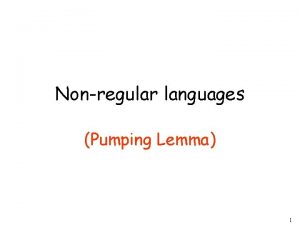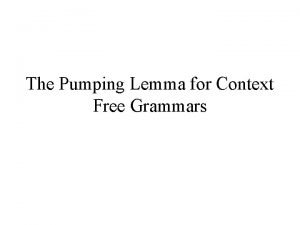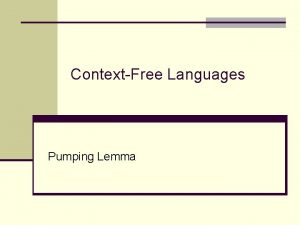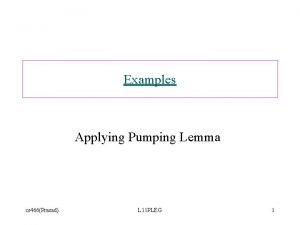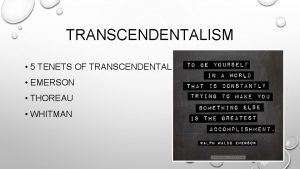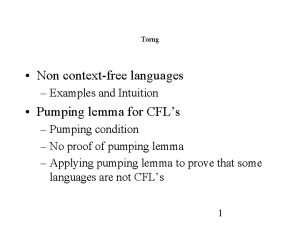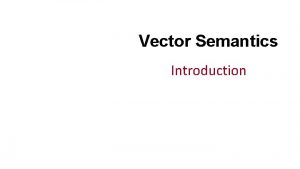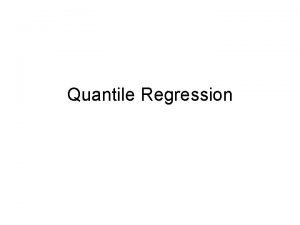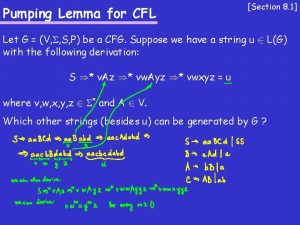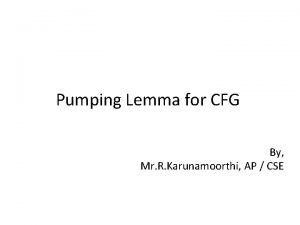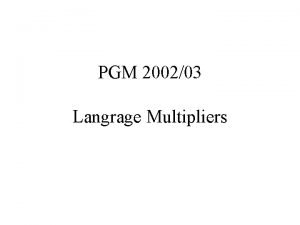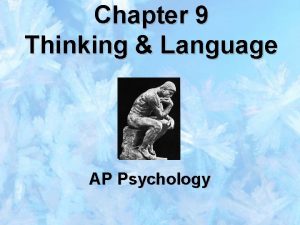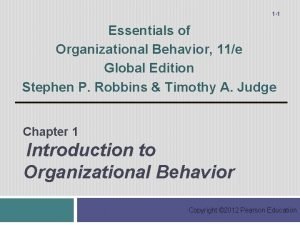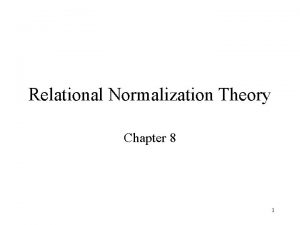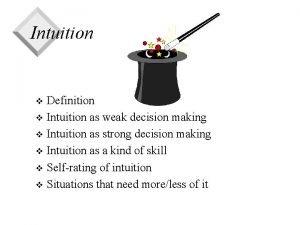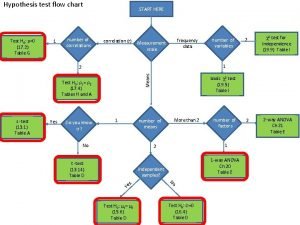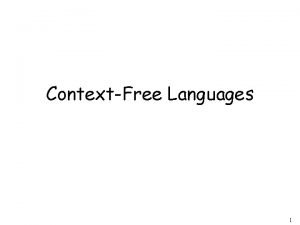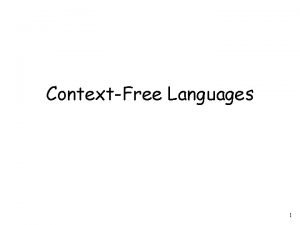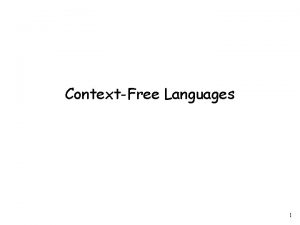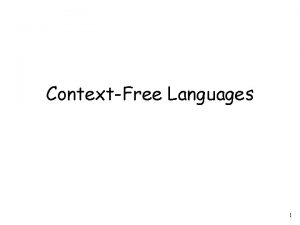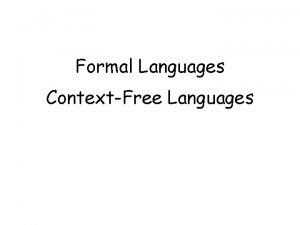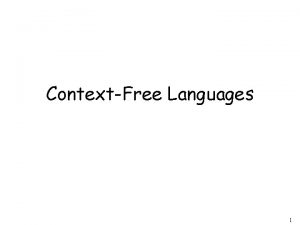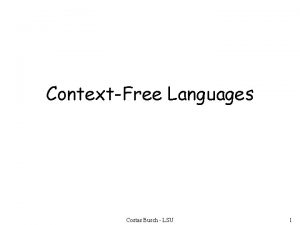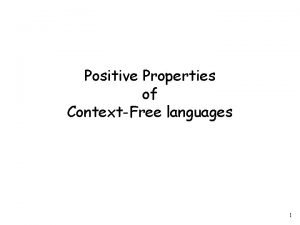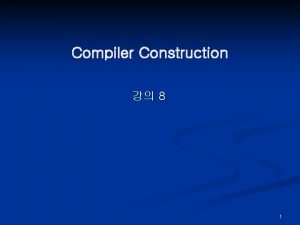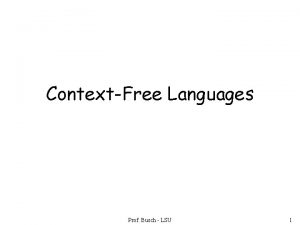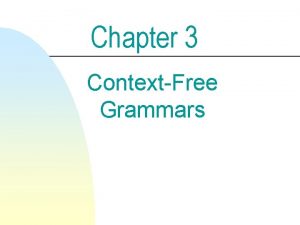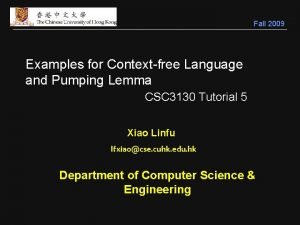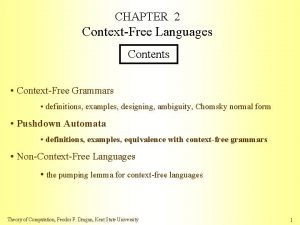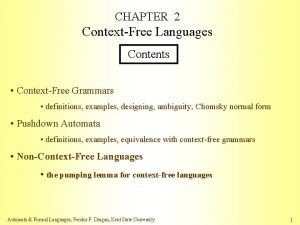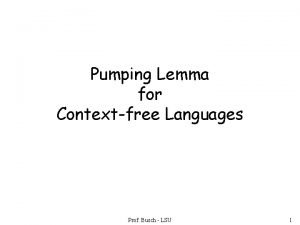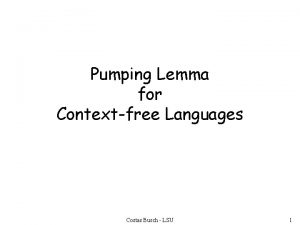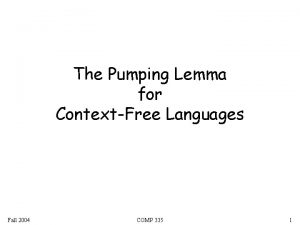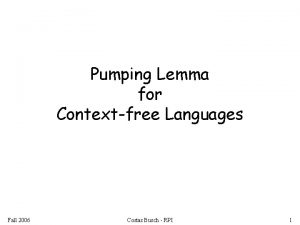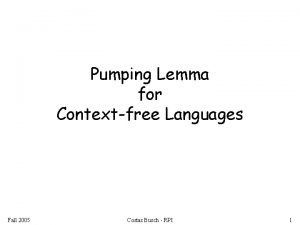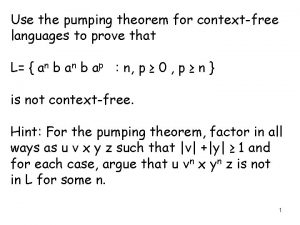Torng Non contextfree languages Examples and Intuition Pumping



























- Slides: 27

Torng • Non context-free languages – Examples and Intuition • Pumping lemma for CFL’s – Pumping condition – No proof of pumping lemma – Applying pumping lemma to prove that some languages are not CFL’s 1

Examples and Intuition 2

Examples • What are some examples of nonregular languages? • Can we build on any of these languages to create a non context-free language? 3

Intuition • Try and prove that these languages are CFL’s and identify the stumbling blocks – Why can’t we construct a CFG to generate this language? – Why can’t we construct a PDA to accept this language? – Compare to similar CFL languages to try and identify differences. 4

Pumping Lemma for CFL’s 5

Comparison to regular language pumping lemma/condition 6

What’s different about CFL’s than regular languages? * • In regular languages, a single substring “pumps” – Consider the language of even length strings over {a, b} – We can identify a single substring which can be pumped • In CFL’s, multiple substrings can “pump” – Consider the language {anbn | n > 0} – No single substring can be pumped and allow us to stay in the language – However, there do exist pairs of substrings which can be pumped resulting in strings which stay in the language • This results in a modified pumping condition 7

Modified Pumping Condition • A language L satisfies the regular language pumping condition if: – there exists an integer n > 0 such that – for all strings x in L of length at least n – there exist strings u, v, w such that • • x = uvw and |uv| ≤ n and |v| ≥ 1 and For all k ≥ 0, uvkw is in L • A language L satisfies the CFL pumping condition if: – there exists an integer n > 0 such that – for all strings x in L of length at least n – there exist strings u, v, w, y, z such that • x = uvwyz and • |vwy| ≤ n and • |vy| ≥ 1 and • For all k ≥ 0, uvkwykz is in L 8

Pumping Lemma • All CFL’s satisfy the CFL pumping condition CFL’s 9

Pumping Implications CFL • We can use the pumping lemma to prove a language L is not a CFL – Show L does not satisfy the CFL pumping condition • We cannot use the pumping lemma to prove a language is context-free – Showing L satisfies the pumping condition does not guarantee that L is context-free 10

Pumping Lemma What does it mean? 11

Pumping Condition • A language L satisfies the CFL pumping condition if: – there exists an integer n > 0 such that – for all strings x in L of length at least n – there exist strings u, v, w, y, z such that • x = uvwyz and • |vwy| ≤ n and • |vy| ≥ 1 and • For all k ≥ 0, uvkwykz is in L 12

v and y can be pumped 1) x in L 2) x = uvwyz 3) For all k ≥ 0, uvkwykz is in L • Let x = abcdefg be in L • Then there exist 2 substrings v and y in x such that v and y can be repeated (pumped) in place any number of times and the resulting string is still in L – uvkwykz is in L for all k ≥ 0 • For example – v = cd and y = f • uv 0 wy 0 z = uwz = abeg is in L • uv 1 wy 1 z = uvwyz = abcdefg is in L • uv 2 wy 2 z = uvvwyyz = abcdcdeffg is in L • uv 3 wy 3 z = uvvvwyyyz = abcdcdcdefffg is in L • … 13

What the other parts mean • A language L satisfies the CFL pumping condition if: – there exists an integer n > 0 such that • Since we skip this proof, we will not see what n really means – for all strings x in L of length at least n • x must be in L and have sufficient length – there exist strings u, v, w, y, z such that • x = uvwyz and • |vwy| ≤ n and – v and y are contained within n characters of x – Note: these are NOT necessarily the first n characters of x • |vy| ≥ 1 and – v and y cannot both be – One of them might be , but not both • For all k ≥ 0, uvkwykz is in L 14

Example • Let L be the set of palindromes over {a, b} – Let x = aabaa – Let n = 3 – What are the possibilities for v and y ignoring the pumping constraint? – Which ones satisfy the pumping lemma? 15

Pumping Lemma Applying it to prove a specific language L is not context-free 16

How we use the Pumping Lemma • We choose a specific language L – For example, {ajbjcj | j > 0} • We show that L does not satisfy the pumping condition • We conclude that L is not context-free 17

Showing L “does not pump” • A language L satisfies the CFL pumping condition if: – there exists an integer n > 0 such that – for all strings x in L of length at least n – there exist strings u, v, w, y, z such that • x = uvwyz and • |vwy| ≤ n and • |vy| ≥ 1 and • For all k ≥ 0, uvkwykz is in L • A language L does not satisfy the CFL pumping condition if: – for all integers n of sufficient size – there exists a string x in L of length at least n such that – for all strings u, v, w, y, z such that • x = uvwyz and • |vwy| ≤ n and • |vy| ≥ 1 – There exists a k ≥ 0 such that uvkwykz is not in L 18

Example Proof • A language L does not satisfy the CFL pumping condition if: – for all integers n of sufficient size – there exists a string x in L of length at least n such that – for all strings u, v, w, y, z such that • x = uvwyz and • |vwy| ≤ n and • |vy| ≥ 1 – There exists a k ≥ 0 such that uvkwykz is not in L • • Proof that L = {aibici | i>0} does not satisfy the CFL pumping condition Let n be the integer from the pumping lemma Choose x = anbncn Consider all strings u, v, w, y, z s. t. • x = uvwyz and • |vwy| ≤ n and • |vy| ≥ 1 • Argue that uvkwykz is not in L for some k ≥ 0 – Argument must apply to all possible u, v, w, y, z – Continued on next slide 19

Example Proof Continued • • Proof that L = {aibici | i>0} does not satisfy the CFL pumping condition Let n be the integer from the pumping lemma Choose x = anbncn Consider all strings u, v, w, y, z s. t. • x = uvwyz and • |vwy| ≤ n and • |vy| ≥ 1 • Argue that uvkwykz is not in L for some k ≥ 0 – Argument must apply to all possible u, v, w, y, z – Continued next column • • Identify possible cases for vwy What is impossible for vwy? • Case 1 – vwy contains no a’s • Case 2 – vwy contains no c’s • Must argue uvkwykz is not in L for both cases described above – Can use different values of k – Continued on next slide 20

Example Proof Continued • Identify possible cases for vwy • What is impossible for vwy? • Case 1: vwy contains no a’s – vy contains at least 1 b or c • follows from • Case 1 – vwy contains no a’s • Case 2 – vwy contains no c’s • Must argue uvkwykz is not in L for both cases described above – Can use different values of k – Continued next column – vwy contains no a’s and – |vy| ≥ 1 – uwz is not in L • uwz has n a’s – follows from fact vwy contains no a’s and x originally had n a’s • uwz has fewer than n b’s or fewer than n c’s – follows from vy contains at least 1 b or c and x originally only had n b’s and n c’s • Continued next slide 21

Example Proof Continued • Case 1: vwy contains no a’s – vy contains at least 1 b or c • Case 2: vwy contains no c’s – vy contains at least • follows from – vwy contains no a’s and – |vy| ≥ 1 – uwz is not in L • uwz has n a’s – follows from fact vwy contains no a’s and x originally had n a’s • uwz has fewer than n b’s or fewer than n c’s – follows from vy contains at least 1 b or c and x originally only had n b’s and n c’s • Continued next column – uv 2 wy 2 z is not in L • uv 2 wy 2 z has n c’s – follows from fact vwy contains no c’s and x originally had n c’s • uv 2 wy 2 z has more than n a’s or more than n b’s – follows from vy contains at least 1 a or b and x originally has n a’s and n b’s • Continued next slide 22

Example Proof Completed • Case 2: vwy contains no c’s – vy contains at least – uv 2 wy 2 z is not in L • uv 2 wy 2 z has n c’s – follows from fact vwy contains no c’s and x originally had n c’s • uv 2 wy 2 z has more than n a’s or more than n b’s – follows from vy contains at least 1 a or b and x originally has n a’s and n b’s • For all possible u, v, w, y, z, we have shown there exists a k ≥ 0 such that – uvkwykz is not in L • Note, we used a different value of k for each case (though we didn’t have to) • Therefore L does not satisfy the CFL pumping condition • There L is not a CFL • Continued next column 23

Other example languages • TWOCOPIES = {ww | w is in {a, b}* } – abbabb is in TWOCOPIES but abaabb is not • EQUAL 3 = the set of strings over {a, b, c} such that the number of a’s equals the number of b’s equals the number of c’s • {aibjck | i < j < k} 24

Pumping Lemma Two rules of thumb 25

Two Rules of Thumb • Try to use blocks of at least n characters in x – For TWOCOPIES, choose x = anbn rather than anbanb • Guarantees v and y cannot be in more than 2 blocks of x • Try k=0 or k=2 – k=0 • This reduces number of occurrences of v and y – k=2 • This increases number of occurrences of v and y 26

Summary • We use the Pumping Lemma to prove a language is not a CFL – Note, does not work for all non CFL languages – Can be strengthened to Ogden’s Lemma • In book • Choosing a good string x is first key step • Choosing a good k is second key step • Typically have several cases for v, w, y 27
 Pumping lemma non regular languages examples
Pumping lemma non regular languages examples Pumping lemma for context-free languages examples
Pumping lemma for context-free languages examples Pumping lemma context free language
Pumping lemma context free language Contradiction in maths
Contradiction in maths Favoring intuition over reason
Favoring intuition over reason Intuition pumps examples
Intuition pumps examples Intuition examples
Intuition examples Example of intuition
Example of intuition Pumping lemma for cfl examples
Pumping lemma for cfl examples Pumping lemma for cfg examples
Pumping lemma for cfg examples La lutte supreme nous appelle tous
La lutte supreme nous appelle tous Carl jung intuition vs sensing
Carl jung intuition vs sensing Values feeling and intuition over reason
Values feeling and intuition over reason Rationalism vs romanticism
Rationalism vs romanticism Romanticism qualities
Romanticism qualities Values feeling and intuition over reason
Values feeling and intuition over reason Applications of pumping lemma for cfl
Applications of pumping lemma for cfl What is intuition
What is intuition J cole my intuitions
J cole my intuitions Lagrange
Lagrange The internship mbti
The internship mbti Dot product intuition
Dot product intuition Framing ap psychology example
Framing ap psychology example Complementing intuition with systematic study
Complementing intuition with systematic study Test intuition
Test intuition Intuition definition
Intuition definition Statistics hypothesis testing flow chart
Statistics hypothesis testing flow chart Understanding your intuition
Understanding your intuition
